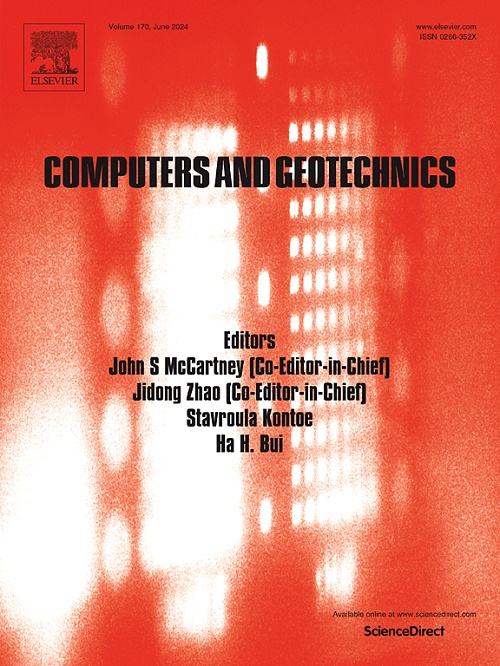Initial hydration characteristics of dry montmorillonite and insights for water transport mechanisms in nanochannels
IF 5.3
1区 工程技术
Q1 COMPUTER SCIENCE, INTERDISCIPLINARY APPLICATIONS
引用次数: 0
Abstract
The early stages of the hydration process in dehydrated montmorillonite (MMT) are crucial for understanding the transition mechanisms between different hydration states of clay minerals. While X-ray Diffraction (XRD) experiments and models provide a macroscopic understanding of the hydration processes of clay minerals, there is still a lack of microscopic models for the transition processes of hydration states, making understanding these transitions at the molecular scale a challenging issue. In this study, molecular dynamics simulations were used to analyze the initial hydration process of water molecules in the dry interlayers of MMT, the mechanisms of their transport, and the influencing conditions. It was found that hydroxyl (–OH) groups formed at the edges of clay particles hinder the entry of water molecules into the montmorillonite channels. Additionally, the properties such as water flux, pressure, and potential energy of the channels were calculated. It was found that the initial hydration process of montmorillonite is influenced by initial conditions such as size, velocity, temperature, interlayer cation type, and number of cations. Entrance effects, exit effects, and disturbances of water molecules were also observed during the initial hydration process. An increase in the ratio of the inlet and outlet sizes of the montmorillonite channel reduces the entrance/exit effect on the density, velocity, and number of water molecules transported, affecting the path of motion of the water transport. In addition, it was found that the number, size, and position of interlayer cations can have a perturbing effect on water molecule transport. The results of this study can be used for the preparation and development of high-precision nanomontmorillonite, the permeation assessment of nuclear waste barriers, and the development of nano-MMT films.
干蒙脱土的初始水化特性及纳米通道中水输运机制研究
脱水蒙脱土水化过程的早期阶段对于理解粘土矿物不同水化状态之间的过渡机制至关重要。虽然x射线衍射(XRD)实验和模型提供了对粘土矿物水化过程的宏观理解,但仍然缺乏水化状态转变过程的微观模型,这使得在分子尺度上理解这些转变成为一个具有挑战性的问题。本研究采用分子动力学模拟的方法,分析了MMT干夹层中水分子的初始水化过程、运输机制及影响条件。研究发现,在粘土颗粒边缘形成的羟基(-OH)阻碍了水分子进入蒙脱土通道。此外,还计算了管道的水通量、压力和势能等特性。研究发现,蒙脱土的初始水化过程受粒径、速度、温度、层间阳离子类型、阳离子数量等初始条件的影响。在初始水化过程中还观察到了水分子的入口效应、出口效应和扰动。蒙脱石通道进出口尺寸比的增大,降低了进出通道对输送水分子的密度、速度和数量的影响,影响了水输送的运动路径。此外,还发现层间阳离子的数量、大小和位置对水分子的运输有扰动作用。研究结果可用于高精度纳米蒙脱土的制备与开发、核废料屏障的渗透评价以及纳米蒙脱土薄膜的开发。
本文章由计算机程序翻译,如有差异,请以英文原文为准。
求助全文
约1分钟内获得全文
求助全文
来源期刊

Computers and Geotechnics
地学-地球科学综合
CiteScore
9.10
自引率
15.10%
发文量
438
审稿时长
45 days
期刊介绍:
The use of computers is firmly established in geotechnical engineering and continues to grow rapidly in both engineering practice and academe. The development of advanced numerical techniques and constitutive modeling, in conjunction with rapid developments in computer hardware, enables problems to be tackled that were unthinkable even a few years ago. Computers and Geotechnics provides an up-to-date reference for engineers and researchers engaged in computer aided analysis and research in geotechnical engineering. The journal is intended for an expeditious dissemination of advanced computer applications across a broad range of geotechnical topics. Contributions on advances in numerical algorithms, computer implementation of new constitutive models and probabilistic methods are especially encouraged.
 求助内容:
求助内容: 应助结果提醒方式:
应助结果提醒方式:


